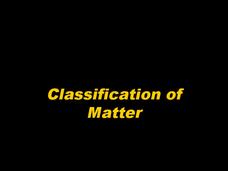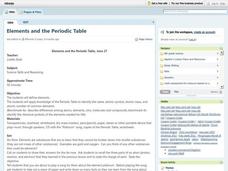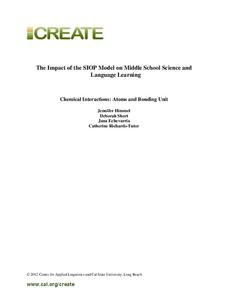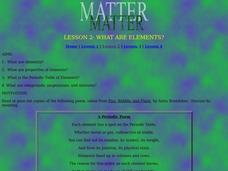Curated OER
What is Matter?
In this matter worksheet, students answer 6 questions about matter. Students distinguish between homogeneous and heterogeneous mixtures, they identify elements and compounds and they distinguish between pure substances and mixtures.
Pearson
The Chemical Context of Life
An educational presentation includes atoms, molecules, the four major elements, as well as neutrons and protons. Additionally, slides focus on atomic number, mass number, atomic weight, polar and nonpolar covalent bonding, ionic bonds,...
Curated OER
Chemical Formula Practice #1/Bonding Basics Practice Page
The first of two worksheets methodically prepares chemistry novices for naming polyatomic compounds. It begins by having them acknowledge the number of each atom contained in a molecule. Then learners list the valence electrons for a...
Curated OER
Hydrocarbons
Making models is always memorable. In this activity, physical science starters examine the structure of hydrocarbons using marshmallows, raisins, and toothpicks. They even act as atoms themselves and link arms to represent covalent...
Curated OER
Atomic Theory
An extremely thorough presentation walks new chemists through the basics of matter. There really isn't a unifying theme, however So many topics are covered: forces, elements, atomic structure, chemical properties, compounds, quarks,...
Curated OER
Mass-Moles-Particles
In this moles activity, learners define a mole and convert grams to moles or moles to molecules. Students convert specific mass of compounds to moles. This activity has 1 true or false, 6 short answer, 3 fill in the blank, and 15...
Curated OER
Physical Science Review Questions
Prepare your class for a quiz with these physical science review questions. Learners respond to 7 questions about ionic and covalent bonds, oxidation states, and chemical and physical changes. In addition, they name compounds and balance...
Curated OER
The Ionic Bond
An introduction to the noble gases shows how full electron shells on an atom makes an element unreactive. Your class will then develop an understanding of how sodium and chlorine react ideally because of their electron arrangement....
Curated OER
Classification of Matter
Thirty-seven slides thoroughly shed light upon the four classes of matter: elements, compounds, mixtures, and solutions. Also covered are chemical symbols, molecules, and chemical equations. The colors and fonts chosen for the...
Curated OER
Ionic Nomenclature
One document contains five different worksheets for practice naming and writing formulas for ionic compounds. The first is particularly notable, as it systematically walks beginning chemists through the process of using the periodic...
Curated OER
Mixtures, Solutions and Matter
In this mixtures, solutions and matter learning exercise, students are given 12 terms and they cut out 12 definitions to match with the terms. Topics include types of mixtures, types of matter such as atoms, molecules and compounds and...
Curated OER
Elements and the Periodic Table
Young scholars are introduced to the elements on the Periodic Table and what is meant by element. Using the Table, they identify the name, atomic mass, number and symbol of each element. To end the lesson, they discover the...
Curated OER
Atoms, Molecules and Ions
Atomic theory, experiments that contributed to our knowledge of matter, atomic structure, isotopes, and ions are covered in these 33 slides. Quality diagrams and labeled charts will help activate understanding. The presentation concludes...
Center for Applied Linguistics
Chemical Interactions: Atoms and Bonding
Watch budding chemists interact with the resource on chemical interactions. In the unit, six lessons provide an overview of basic chemistry, from understanding the development of atomic theory to distinguishing between ionic and covalent...
Curated OER
Bank On It! Compounds and Elements
In this science worksheet, students use words from a word bank to fill in 25 blanks in a cloze story about compounds and elements.
Curated OER
What Are Elements?
Students investigate elements by by defining scientific terms. In this Periodic Table of Elements instructional activity, students utilize a glass of water, and powdered fruit drink to perform a lab activity demonstrating properties of...
Curated OER
Compounds and Mixtures
In this compounds worksheet, students draw a line to match the word with the definition. Students also match foods with their correct term.
Curated OER
Moles
For this moles worksheet, students determine the mole ratio in given compounds and calculate the number of moles of specific elements in chemical compounds. This worksheet has 19 problems to solve.
Curated OER
Atoms, Elements, Molecules, and Compounds
In this elements worksheet, students review the Bohr model and define negative and positive subatomic particles. Students compare molecules and compounds. This worksheet has 11 short answer questions and 4 problems to solve.
Curated OER
Atoms, Kinetic Theory, Solids and Fluids
Students identify and describe the building blocks that make up an atom. They also compare the ages of atoms to the ages of the materials they compose,as well as, give examples that illustrate the small size of atoms.
Curated OER
Predicting and Naming Polyatomic Ionic Compounds Worksheet
For this compounds worksheet, students write the polyatomic ionic compound formulas or the compound names. This worksheet has 29 problems to solve.
Curated OER
Atoms or Molecules?
In this scientific investigation worksheet, students follow the provided procedures to examine the chemical reactions of hydrogen and oxygen atoms and then respond to 1 short answer question.
Curated OER
Differentiate Elements, Compounds, and Mixtures
Students examine the differences between elements, compounds and mixtures. Using diagrams, they compare and contrast atoms and molecules and describe various chemical reactions. They distinguish the differences between ionic and...
Curated OER
Atoms
In this atoms worksheet, students circle the term in parentheses that makes the 20 statements correct. The statements review the parts of an atom, isotopes, and basic matter principles.

























